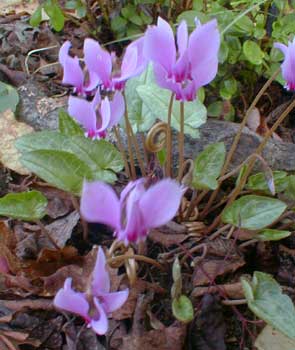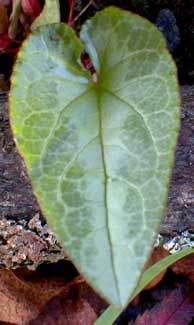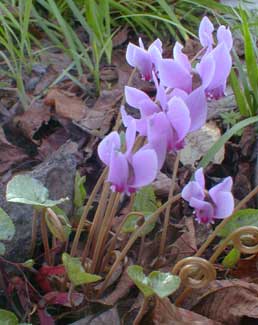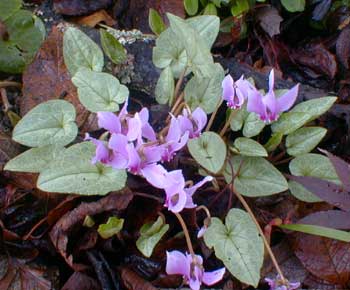
Cordate 'Silver Cloud' Rose Pink
Silverleaf (Pewter Group)
Autumn Cyclamen
"Thou Cyclamen of crumpled horn
Toss not thy head aside;
Repose it where the Loves were born,
In that warm dell abide.
Whatever flowers, on mountain, field,
Or garden, may arise,
Thine only that pure odor yield
Which never can suffice.
Emblem of her I've loved so long,
Go, carry her this little song."
-Walter Savage Landor
(1775-1864)
(1775-1864)
 Leaf forms of Cyclamen hederifolium are not quite as varied as the pattern forms, but even so awfully varied. Its species name means "Ivy-leafed" because of the usual shape, deckled to smooth sagittate or hastate. But some few are ovate (egg-shaped) to cordate (heart-shaped). This one's a narrow elongated cordate leaf with nearly smooth edges.
Leaf forms of Cyclamen hederifolium are not quite as varied as the pattern forms, but even so awfully varied. Its species name means "Ivy-leafed" because of the usual shape, deckled to smooth sagittate or hastate. But some few are ovate (egg-shaped) to cordate (heart-shaped). This one's a narrow elongated cordate leaf with nearly smooth edges.Both 'White Cloud ' & 'Silver Cloud' were developed by Gloucestershire cyclamenist Phil Cornish, bred from 'Bowles' Apollo.' 'Silver Cloud' is essentially the pink-flowering version of white-blooming 'White Cloud,' but not as stable for its leaf shape & color.
Some 'Silver Cloud' specimens are evenly silvered, others show a bit of patterning especially around the edges. This one is most interestingly patterned with mottling & webbing over much of the leaf, but with a more intensely silvered central zone, void of the green hastate silhouette that would be more typical of the species.
Not all have such perfect, narrow cordate leaves either, as some are much broader & show at least hints of lobes. This one was selected from a larger group specifically because the cordate shape was more perfect than the others.
 For this specimen, the leaves tend to appear mid to late October. They're well-formed hearts right from emergence. They begin their appearance standing upright & folded somewhat like tubes, then unfold themselves as they bend back parallel to the ground.
For this specimen, the leaves tend to appear mid to late October. They're well-formed hearts right from emergence. They begin their appearance standing upright & folded somewhat like tubes, then unfold themselves as they bend back parallel to the ground.When fully mature, the leaves are still only half the size of the foliage for most other C. hederifolium. It is also shorter to the ground in its leaf arrangement. The majority of autumn-blooming C. hederifolium at four to six inches height grow enough higher than winter-blooming C. coum that the two species must be planted far enough away form one another that C. hederifolium will not hide if not displace C. coum. But varieties with smaller leaves & horizontal stature, like this cordate 'Silver Cloud' with smaller leaves than the norm even for its variety, or the reliably ddwarf 'Green Elf,' can be interplanted with C. coum for an area of autumn-to-spring groundcover that will have cyclamen blossoms minimally from September to March.
Blooms begin approximately late September just before leaves pop up their pointy heads, & can last all October & into November. This one's a particularly floriferous clump both before & after leaf development. When the flowers are done, the shimmering leaves, themselves as bright as flowers, persist into early Spring, & are not generally marred by pests.
 A mildly interesting side-note on pronunciation. In America cyclamen is almost universally pronounced SY-kla-men but in England they frequently say SICK-la-men. In several non-English speaking countries they say KY-kla-men. It's from a Greek word meaning "Circular" apparently alluding to the disc-shaped tubor & the spokes-of-a-wheel arrangement of the flower petals & the coiled stems which literally plant their own seeds when these spring-loaded coils press their ripened seeds into the soil.
A mildly interesting side-note on pronunciation. In America cyclamen is almost universally pronounced SY-kla-men but in England they frequently say SICK-la-men. In several non-English speaking countries they say KY-kla-men. It's from a Greek word meaning "Circular" apparently alluding to the disc-shaped tubor & the spokes-of-a-wheel arrangement of the flower petals & the coiled stems which literally plant their own seeds when these spring-loaded coils press their ripened seeds into the soil.Hardy cyclamens thrive in the open garden so long as they have perfect soil drainage. They like moist well draining soil in autumn & winter when they are at the height of activity, but they want dry soil during late spring & summer dormancy. They'll survive an irrigated area in summer so long as the soil drains swiftly, or the tubers are placed close to the trunks of trees or large shrubs where soil never remains moist long at a time.
They can stand just about any soil condition from humusy & acidic to light & somewhat alkaline, just so long as it drains well. With the one proviso of never experiencing summer sogginess, they're unkillable plants that require very little maintenance.
C. hederifolium likes partial to deep shade. It's one of the finest plants on earth for those difficult "dry shade" areas, though if autumn rain or irrigation doesn't reach them as their growing season begins, they will break dormancy much more slowly. They seem to do well in even the harshest locations, however, though they will never want full sunlight which will cook the shallowly planted tubers & burn up the leaves & flowers.
In much of their range they prefer to grow under evergreen trees so that they will not be too sunned during autumn & winter. Here in the Pacific Northwest, however, the days are quite short in winter, & they do not become too sunned if grown under deciduous trees & shrubs, though one does have to remove the autumn leaf-fall from atop the cyclamens so that they show themselves to best advantage.
The older the tuber gets the more flowers it will produce until it will provide an intense broad clump of pink blooms followed quickly by the gorgeous leaves which eventually extend to a foot width (or wider in great old age, the tubers living for decades upon decades).
Continue to
Cyclamen hederifolium 'Nettleton Silver' Shell Pink